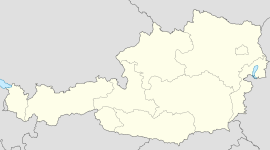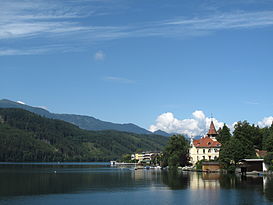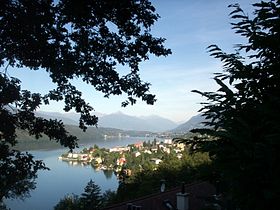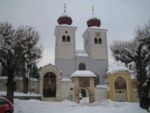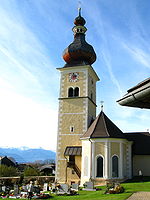- Millstatt
-
Coordinates: 46°48′19″N 13°34′18″E / 46.80528°N 13.57167°E
Millstatt Country Austria State Carinthia District Spittal an der Drau Mayor Josef Pleikner (ÖVP) Area 57.81 km2 (22 sq mi) Elevation 611 m (2005 ft) Population 3,418 (1 January 2011)[1] - Density 59 /km² (153 /sq mi) Time zone CET/CEST (UTC+1/+2) Licence plate SP Postal code 9872 Area code 4766 Millstatt (Slovene: Milje) is a market town in Carinthia, Austria. Within the Central Eastern Alps it is situated on a peninsula on the northern shore of the Lake Millstatt, in the district of Spittal an der Drau.
The traditional health resort and spa town is known for its former Benedictine abbey, founded about 1070. The municipality of Millstatt also contains the Katastralgemeinden Obermillstatt, Matzelsdorf and Laubendorf.
Contents
History
While the oldest archaeological artifacts found in the area date back to the Neolithic, the name "Millstatt" may refer to the Celtic expression "mils" meaning mountain stream or brook. The Celts entered this region from the 5th century BC onwards, their kingdom Noricum came under control of the Roman Empire in 16 BC. During the Migration Period in the 6th century Slavic tribes settled here in the principality of Carantania, which became a march of Bavaria and the Frankish Empire in the late 8th century. According to legend, a Carantanian duke Domitian († 802?) converted to Christianity and built the first church of Millstatt. He also had one thousand statues of pagan gods ("mille statuae", see the coat of arms) gathered and thrown into the lake.
About 1070 the Bavarian Count Palatine Aribo II and his brother Poto established Millstatt Abbey, a Benedictine monastery, in Millstatt including a donation of extensive landed property around the lake and estates in Salzburg and Friuli. Although no document is saved the first monks probably descended from Hirsau Abbey. While the Counts of Gorizia, Ortenburg and Cilli held the office of a Vogt protector the monastic community included up to 150 brothers, who made Millstatt a cultural centre of Upper Carinthia and left a famous codex - the Millstatt manuscript - in Middle High German language from around 1200. The decline of the monastery in consequence of economic and disciplinary difficulties led to its abolition by Pope Paul II in 1469.
Emperor Frederick III of Habsburg, by this time Vogt of Millstatt, had urged on this decision for the sake of his foundation of the knightly order of St. George to which he handed over the monastery and its estates on 14 May 1469. The order was meant to serve as a protector against the increasing attacks of the Ottoman Empire, but the very few knights did not succeed and the area was devastated by the Turks several times between 1473 and 1483. After the death of Emperor Maximilian I in 1519 the disbandment of the order began until its final abolition in 1598.
 Millstatt about 1680 by Janez Vajkard Valvasor
Millstatt about 1680 by Janez Vajkard Valvasor
Meanwhile the Reformation had spread throughout Carinthia and the majority of the population had turned Protestant. Ferdinand II of Habsburg, regent of Inner Austria and later Holy Roman Emperor intended to exterminate Protestantism in his hereditary lands and therefore furnished the Graz Jesuit College with the benefit of the Millstatt monastery. From 1598 onwards the Jesuits pushed the Counter-Reformation by convincing as well as forcing the local inhabitants to return to the Catholic belief. The history of the monastery came to an end, when the Jesuit order was suppressed by Pope Clement XIV in 1773.
Afterwards Millstatt fell into meaninglessness until from about 1870 forth it developed to a fashionable summer resort for the nobility and the wealthy bourgeoisie of the Austro-Hungarian Empire.
Sights
Beneath the market stand the extensive buildings of the former Benedictine monastery with its four massive Renaissance towers situated between the former knightly palace of the order of St. George finished in 1499 and the monastery church at the highest point in the north.
The building, now parish church of Christ the Savior and All Saints, was erected in the second quarter of the 12th century. It replaced an earlier church from the days of the Carolingian dynasty, of which some cut stone slabs remained in secondary utilization. The westwork with the characteristic twin steeples was attached between 1166 and 1177, the Baroque onion domes about 1670. Underneath the towers the entrance hall has a Romanesque rib vault and a fresco from 1428 showing the Passion of Christ. Seven arches form the Romanesque portal from about 1170 with a manifold figurative decoration. The nave itself is a Romanesque basilica, while on several piers are frescoes from about 1430 and the Gothic apse as well as the lierne vault with 149 coats of arms date from 1516. The Baroque high altar was manufactured under the Jesuits in 1648, put on the wall to the right is now a large fresco of the Last Judgement from about 1515, which had to be removed from its original place on the outside wall of the westwork. Two chapels at the north and at the south side with the tombstones of the first two Grand Masters of the order of St. George were added between 1490 and 1505.
In the Romanesque cloister south of the church the capitals of some columns date back to the 12th century. It was furnished with a Late Gothic groin vault and frescoes of the Madonna about 1500. The Renaissance monastery buildings with their arcades are situated to the west and the south of the courtyard. From the abbey leads a Way of the Cross up to the Baroque chapel of Calvary hill, a heritage of the Jesuits as well as, in the east of the town, the High Cross monument from the 18th century.
The parish church St. Johann Baptist of Obermillstatt ("Upper Millstatt") was already mentioned in 1205, though the nowadays building has been erected under the Jesuit rule in 1614. Its Baroque furnishing includes a square groin vault apse and a high altar from around 1720. Situated on a slope above the village, the church can be widely seen by its massive tower with the big onion dome.
Up in Matzelsdorf is the small pilgrimage church Maria Schnee (Our Lady of the Snows), which was first mentioned in 1177. The small but richly decorated nave has a Late Gothic lierne vault from the 16th century and Baroque frescoes of the Madonna from about 1716. The retable of the altar with a carving work of the coronation of Mary probably originates from around 1500.
Near Laubendorf is the foundation of a small Early Christian church from the 5th century, which has been preserved in quite good condition. In the place of the altar is a former reliquary, covered by a Roman tombstone. The church probably was built as a refuge for the diocese of nearby Tiburnia in the days of the Decline of the Roman Empire. It finally was abandoned around 600 when the Slavic Carantanians entered the region.
Culture
The monastery museum is situated within in the cloister and presents a summary of the abbey's history and its cultural heritage, e.g. Neolithic artifacts and facsimiles of the Millstatt manuscript. The collection also includes a Romanesque shrine from about 1140, a dungeon from the 16th century and a Renaissance chest from the studio of Andrea Mantegna. The cassone once was part of the dowry of Paola Gonzaga, the daughter of Ludovico II of Gonzaga and deceased wife of Count Leonhard of Gorizia, who bequested it to the Order of St. George in 1495.
Since 1981 the "Millstatt Symposium", an academic conference, takes place every year, where researchers discuss different subjects concerning the history of Millstatt and Carinthia.
In summer the "Musikwochen Millstatt" (Millstatt Music Weeks) festival performs various concerts in and around the monastery church including sacred music, choral and classical works as well as jazz, chamber music, piano and organ recitals.
Politics
Seats in the municipal assembly (Gemeinderat) as of 2009 elections:
- Austrian People's Party (ÖVP): 9
- Alliance for the Future of Austria (BZÖ): 6
- Social Democratic Party of Austria (SPÖ): 5
- NHK (Independent): 2
- Freedom Party of Austria (FPÖ): 1
Twin towns — sister cities
See also: List of twin towns and sister cities in AustriaMillstatt is twinned with:
 Heligoland, Germany, since 1974
Heligoland, Germany, since 1974 Wendlingen, Germany, since 1992
Wendlingen, Germany, since 1992 San Daniele del Friuli, Italy, since 1993
San Daniele del Friuli, Italy, since 1993
Notable people
- Felix von Luschan (1854 – 1924), anthropologist, is buried at the Millstatt churchyard.
References
Literature
- (German) Matthias Maierbrugger, Die Geschichte von Millstatt, Klagenfurt, 1964.
External links
- (German) Official site
- aeiou Encyclopedia
Bad Kleinkirchheim · Baldramsdorf · Berg im Drautal · Dellach im Drautal · Flattach · Gmünd · Greifenburg · Großkirchheim · Heiligenblut · Irschen · Kleblach-Lind · Krems · Lendorf · Lurnfeld · Mallnitz · Malta · Millstatt · Mörtschach · Mühldorf · Oberdrauburg · Obervellach · Radenthein · Rangersdorf · Reißeck · Rennweg am Katschberg · Sachsenburg · Seeboden · Spittal an der Drau · Stall · Steinfeld · Trebesing · Weissensee · Winklern
 Categories:
Categories:- Cities and towns in Carinthia
Wikimedia Foundation. 2010.


